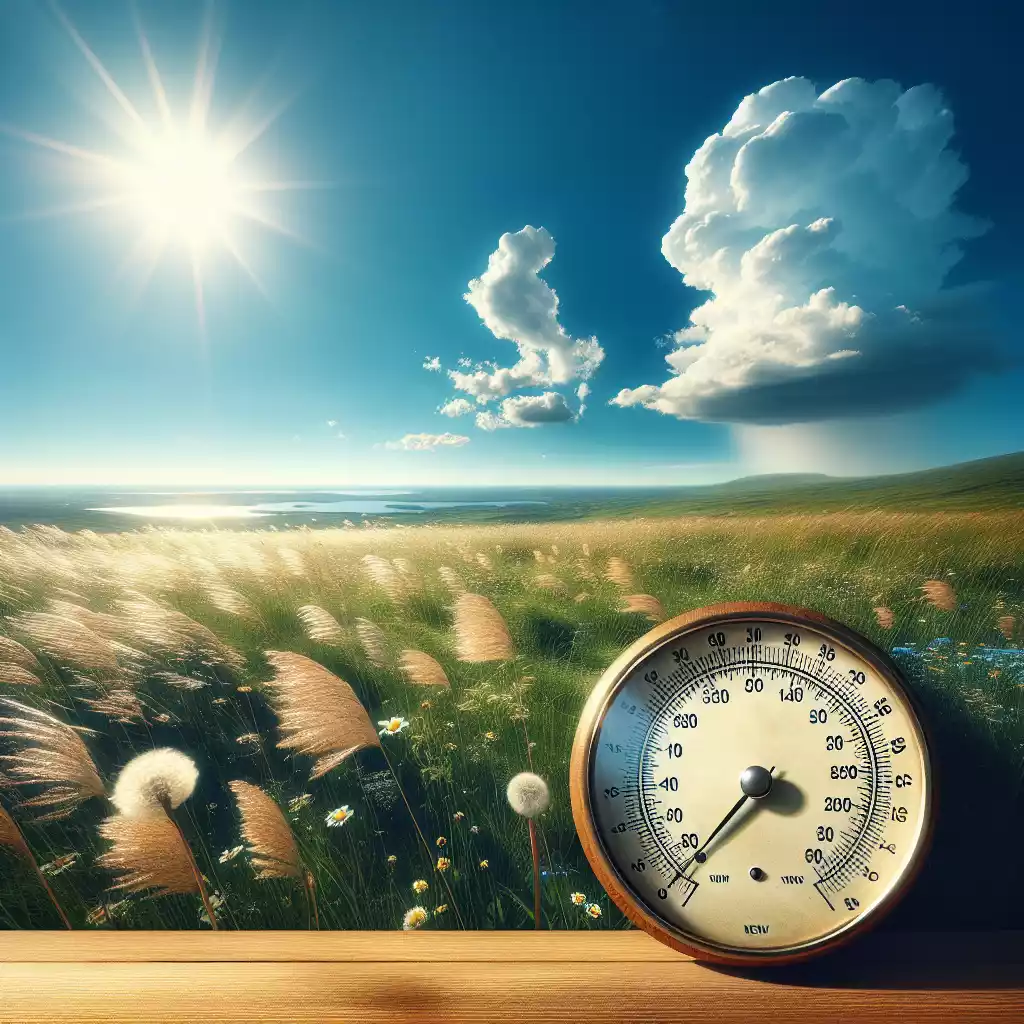High air pressure often brings about specific weather conditions that can be both predictable and beneficial. When the atmospheric pressure is high, it generally means that the air is descending, which inhibits the formation of clouds and precipitation. This results in clear skies, calm weather, and stable atmospheric conditions. Historically, sailors and farmers have relied on high-pressure systems to predict fair weather, making it a crucial element in weather forecasting.
Understanding High Air Pressure
Definition of High Air Pressure
High air pressure, also known as a high-pressure system or anticyclone, occurs when the atmospheric pressure at the Earth’s surface is higher than its surrounding environment. This phenomenon is measured using a barometer, and readings above 1013.25 millibars (the average sea-level pressure) typically indicate a high-pressure system.
Historical Context of High Air Pressure Studies
The study of high air pressure dates back to the 17th century when Evangelista Torricelli invented the barometer. This invention allowed scientists to measure atmospheric pressure accurately and understand its impact on weather patterns. Over the centuries, meteorologists have developed sophisticated models to predict weather changes based on high-pressure systems.
How High Air Pressure Affects Weather
General Weather Patterns
High-pressure systems are associated with calm and stable weather. The descending air suppresses cloud formation, leading to clear skies and minimal precipitation. This stability can last for several days, providing a period of consistent weather.
Seasonal Variations
The impact of high air pressure can vary with the seasons. In summer, high-pressure systems can lead to hot and dry conditions, while in winter, they can result in cold and clear weather. Understanding these seasonal variations is essential for accurate weather forecasting.
High Air Pressure and Clear Skies
Why High Air Pressure Leads to Clear Skies
High air pressure causes air to descend, which warms up as it compresses. This warming inhibits cloud formation, resulting in clear skies. The lack of clouds allows for more sunlight to reach the Earth’s surface, contributing to brighter and sunnier days.
Case Studies of Clear Skies Due to High Air Pressure
Historical weather data shows that regions under the influence of high-pressure systems experience prolonged periods of clear skies. For example, the “Indian Summer” in North America is often attributed to high-pressure systems that bring warm and clear weather during the fall.
High Air Pressure and Temperature
Impact on Daytime Temperatures
During the day, high-pressure systems can lead to higher temperatures due to the increased sunlight and lack of cloud cover. This effect is more pronounced in the summer months when the sun’s rays are more direct.
Impact on Nighttime Temperatures
At night, the absence of clouds can lead to rapid cooling of the Earth’s surface, resulting in lower temperatures. This phenomenon is known as radiational cooling and can cause significant temperature drops in areas under high-pressure systems.
High Air Pressure and Wind Patterns
Wind Speed and Direction
High-pressure systems are typically associated with light winds. The descending air creates a stable atmosphere, reducing the likelihood of strong winds. However, the wind direction around a high-pressure system is clockwise in the Northern Hemisphere and counterclockwise in the Southern Hemisphere.
Regional Wind Patterns
Different regions experience unique wind patterns due to high-pressure systems. For instance, the “Santa Ana winds” in Southern California are dry and warm winds that blow from the inland deserts towards the coast, influenced by high-pressure systems.
High Air Pressure and Humidity
Relationship Between High Air Pressure and Humidity Levels
High-pressure systems often lead to lower humidity levels. The descending air compresses and warms up, reducing its capacity to hold moisture. This results in drier conditions, which can be beneficial for outdoor activities but challenging for agriculture.
Effects on Human Comfort
Lower humidity levels can make hot temperatures feel more bearable, but they can also lead to dry skin and respiratory discomfort. It’s essential to stay hydrated and use moisturizers during prolonged periods of high pressure.
High Air Pressure and Precipitation
Reduced Chances of Rain
High-pressure systems suppress cloud formation, significantly reducing the chances of rain. This can lead to dry spells, which are beneficial for outdoor events but can cause drought conditions if prolonged.
Impact on Snowfall
In winter, high-pressure systems can lead to clear and cold conditions, reducing the likelihood of snowfall. However, if a high-pressure system moves over a region with existing snow cover, it can lead to very cold temperatures due to radiational cooling.
High Air Pressure and Storms
Suppression of Storm Formation
High-pressure systems inhibit the formation of storms by stabilizing the atmosphere. This suppression can prevent thunderstorms, hurricanes, and other severe weather events, providing a period of calm weather.
Historical Storm Data
Historical data shows that regions under the influence of high-pressure systems experience fewer storms. For example, the Atlantic hurricane season often sees a decrease in storm activity when a strong high-pressure system is present.
High Air Pressure and Air Quality
Impact on Pollution Levels
High-pressure systems can lead to poor air quality by trapping pollutants near the Earth’s surface. The stable atmosphere prevents the dispersion of pollutants, leading to smog and other air quality issues.
Health Implications
Poor air quality can have significant health implications, especially for individuals with respiratory conditions. It’s essential to monitor air quality levels and take precautions during high-pressure periods.
High Air Pressure and Agriculture
Effects on Crop Growth
High-pressure systems can have both positive and negative effects on agriculture. While clear skies and dry conditions can benefit some crops, prolonged dry spells can lead to drought and negatively impact crop yields.
Historical Agricultural Data
Historical agricultural data shows that high-pressure systems have played a significant role in crop production. For example, the Dust Bowl of the 1930s was exacerbated by prolonged high-pressure systems that led to severe drought conditions.
High Air Pressure and Aviation
Impact on Flight Conditions
High-pressure systems generally provide favorable flight conditions with clear skies and stable weather. However, the lack of wind can lead to longer flight times for aircraft that rely on tailwinds.
Case Studies in Aviation
Several aviation case studies highlight the benefits of high-pressure systems for flight safety and efficiency. For instance, clear skies and stable weather conditions are ideal for takeoffs and landings.
High Air Pressure and Marine Conditions
Effects on Sea State
High-pressure systems can lead to calm sea conditions, making it easier for marine navigation. The lack of strong winds reduces wave heights, providing a smoother sailing experience.
Impact on Marine Navigation
Calm sea conditions under high-pressure systems are beneficial for marine navigation. Historical records show that sailors have long relied on high-pressure systems to ensure safe and efficient voyages.
High Air Pressure and Wildlife
Behavioral Changes in Animals
High-pressure systems can influence animal behavior. For example, birds often take advantage of clear skies and calm weather to migrate, while other animals may become more active during these periods.
Case Studies in Wildlife
Several wildlife studies have documented behavioral changes in animals during high-pressure periods. For instance, migratory patterns of birds and the activity levels of mammals are often influenced by high-pressure systems.
High Air Pressure and Human Activities
Outdoor Activities
High-pressure systems provide ideal conditions for outdoor activities such as hiking, camping, and sports. The clear skies and stable weather make it easier to plan and enjoy outdoor events.
Indoor Activities
While high-pressure systems are generally associated with outdoor activities, they can also impact indoor activities. For example, the increased sunlight can reduce the need for artificial lighting, leading to energy savings.
Common Misconceptions About High Air Pressure
Myths and Facts
There are several misconceptions about high air pressure. For example, some people believe that high-pressure systems always bring hot weather, but this is not true in winter. Understanding the facts can help dispel these myths.
Scientific Clarifications
Scientific research provides clarity on the effects of high air pressure. For instance, while high-pressure systems generally bring clear skies, they can also lead to poor air quality due to trapped pollutants.
Conclusion
High air pressure plays a crucial role in shaping weather patterns. From clear skies and stable temperatures to its impact on agriculture and human activities, understanding high-pressure systems is essential for accurate weather forecasting and planning. By recognizing the effects of high air pressure, we can better prepare for the weather conditions it brings and make informed decisions in various aspects of life.
Relevant Data Table
| Aspect | Impact of High Air Pressure |
|---|---|
| Clear Skies | Inhibits cloud formation, leading to clear skies. |
| Temperature | Higher daytime temperatures, lower nighttime temperatures. |
| Wind Patterns | Light winds, clockwise in Northern Hemisphere, counterclockwise in Southern Hemisphere. |
| Humidity | Lower humidity levels, resulting in drier conditions. |
| Precipitation | Reduced chances of rain and snowfall. |
| Storms | Suppression of storm formation. |
| Air Quality | Potential for poor air quality due to trapped pollutants. |
| Agriculture | Mixed effects on crop growth, potential for drought. |
| Aviation | Favorable flight conditions with clear skies and stable weather. |
| Marine Conditions | Calm sea conditions, beneficial for navigation. |
| Wildlife | Influences animal behavior, such as migration patterns. |
| Human Activities | Ideal for outdoor activities, impacts indoor activities. |
FAQs
FAQ 1: How does high air pressure affect weather patterns?
High air pressure affects weather patterns by creating stable atmospheric conditions. The descending air inhibits cloud formation, leading to clear skies and minimal precipitation. This stability can last for several days, providing consistent weather. High-pressure systems are often associated with calm and dry weather, making them a key factor in weather forecasting.
FAQ 2: Why do high-pressure systems lead to clear skies?
High-pressure systems lead to clear skies because the descending air warms up as it compresses, inhibiting cloud formation. This lack of clouds allows more sunlight to reach the Earth’s surface, resulting in brighter and sunnier days. The stable atmosphere created by high-pressure systems prevents the development of clouds and precipitation.
FAQ 3: What are the effects of high air pressure on temperature?
High air pressure can impact temperatures in different ways. During the day, the increased sunlight and lack of cloud cover can lead to higher temperatures. At night, the absence of clouds can cause rapid cooling of the Earth’s surface, resulting in lower temperatures. This phenomenon, known as radiational cooling, can cause significant temperature drops in areas under high-pressure systems.
FAQ 4: How does high air pressure influence wind patterns?
High-pressure systems are typically associated with light winds. The descending air creates a stable atmosphere, reducing the likelihood of strong winds. The wind direction around a high-pressure system is clockwise in the Northern Hemisphere and counterclockwise in the Southern Hemisphere. Different regions experience unique wind patterns due to high-pressure systems.
FAQ 5: What are the health implications of high air pressure?
High air pressure can lead to poor air quality by trapping pollutants near the Earth’s surface. The stable atmosphere prevents the dispersion of pollutants, leading to smog and other air quality issues. Poor air quality can have significant health implications, especially for individuals with respiratory conditions. It’s essential to monitor air quality levels and take precautions during high-pressure periods.
—
This article provides a comprehensive overview of the weather conditions associated with high air pressure. From clear skies and temperature variations to its impact on agriculture and human activities, understanding high-pressure systems is essential for accurate weather forecasting and planning. By recognizing the effects of high air pressure, we can better prepare for the weather conditions it brings and make informed decisions in various aspects of life.
How does atmospheric pressure affect weather?
Welcome to the AI Blogging World! No need to stick with old-school methods anymore. I use AI to help you, but it won’t leave any footprint behind. With over 7 years of experience in content writing and digital marketing, you’re in the right place. From my personal experience, I know what format and quality Google loves for your blog. You’ll get the best results using this AAA tool.






